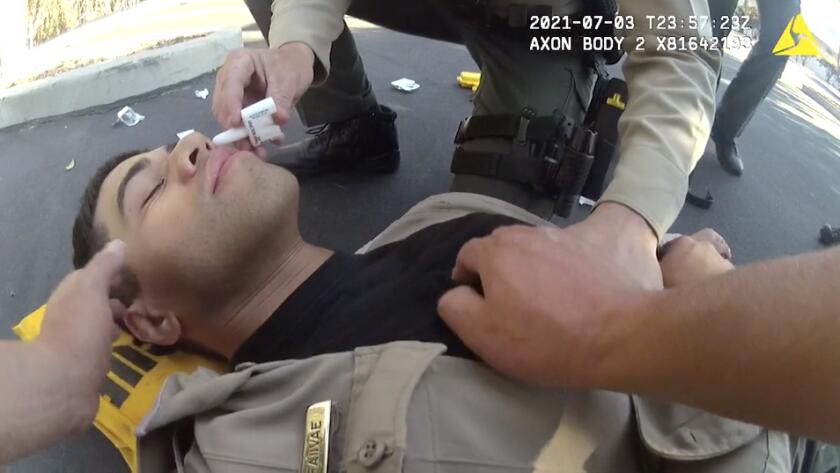Authorities say San Diego County deputy overdosed after coming in contact with fentanyl
- Share via
San Diego County sheriff’s officials say a deputy’s life was saved by his colleague after he overdosed because of an accidental fentanyl exposure. (San Diego County Sheriff’s Department)
- Share via
SAN DIEGO — Authorities say the accidental fentanyl exposure hit Deputy David Faiivae quickly. It was an overdose, they said, and he was dying.
A body-worn camera caught the moment Faiivae collapsed flat on his back in a San Marcos parking lot last month, seconds after he finished testing a white powder he’d suspected was either cocaine or fentanyl, according to the San Diego County Sheriff’s Department.
For the record:
2:16 p.m. Aug. 10, 2021This story misstates what was known about the medical condition of the deputy shown in the Sheriff Department’s video. The conclusion that his collapse was caused by contact with fentanyl was supplied by the Sheriff’s Department rather than by qualified medical experts, who have since cautioned that the risks from incidental contact are often overstated. A study published in the International Journal of Drug Policy in June found that law enforcement agents across the country “wrongly believed that dermal exposure to fentanyl was deadly and expressed fear about such exposure on scene.”
A follow-up story can be found here.
A deeper look at the skepticism over the video can be found here. The experts said the risks of so-called passive exposure to synthetic opioids such as fentanyl are overblown and that inaccurate messaging can instill unnecessary fear in first responders.
The deputy stared into the sky. He would later say in a video officials released that his lungs locked as he struggled for air. The Sheriff’s Department said that if not for a quick-thinking partner, he would be dead.
Faiivae’s experience July 3 was the subject of a 4-minute video released by the Sheriff’s Department on Thursday.
The incident is the latest public warning from officials about the dangers of fentanyl, a drug blamed for 461 fatal overdoses in San Diego County in 2020, with officials saying that number could hit 700 for 2021. The drug increasingly is being smuggled to inmates in county jails as well.
Undersheriff Kelly Martinez said the video prompted internal discussions about training, as well as the need to release it publicly to demonstrate the dangers of fentanyl, a deadly synthetic drug 50 times more potent than heroin.
“We are still seeing it increasing all the time,” Martinez said of fentanyl use.
With body-worn cameras rolling, Faiivae’s training officer tells Faiivae the substance he found had tested positive for fentanyl. He cautions his trainee “that stuff’s no joke — it is super dangerous.”
Faiivae then takes a step backward and topples over.
Cpl. Scott Crane checks on the deputy and then races to his patrol car for naloxone, known by the brand name Narcan, a nasal spray used to reverse the effects of opioids. “I ran over to him and I grabbed him, and he was OD-ing,” Crane later recalled.
Crane sprays the medication into one of Faiivae’s nostrils, then the other, and moves to loosen Faiivae’s bulletproof vest under his uniform shirt.
“Just breathe, buddy, breathe,” Crane tells Faiivae, according to the video. When Crane asks his trainee whether he is OK, Faiivae replies in a weak voice: “I’m sorry.”
“You’re OK. Don’t be sorry…. I got you, OK?” Crane says. “I’m not going to let you die. I’m not going to let you die.”
Authorities say Faiivae’s illness happened around 4 p.m. in a parking lot off North Twin Oaks Valley Road, during his first radio call of his day. The deputy works patrol out of the San Marcos sheriff’s station. It was his final day of shadowing the veteran Crane, officials said.
They are not sure if the fentanyl got onto the deputy’s skin or if he inhaled it. The department released an edited copy of the body cam video but no medical records detailing Faiivae’s exposure.
There has been much debate about the kinds of exposure to fentanyl necessary to cause serious health dangers. Some experts are highly skeptical that simply touching the drug can cause an overdose.
Doctors have said casual skin contact with the drug is unlikely to cause an overdose in most cases.
Still, the Centers for Disease Control and Prevention has urged first responders take extreme caution in dealing with the drug, offering a long list of safety procedures.
Martinez, the undersheriff, credits Crane with having Narcan nearby as deputies tested the white powder. “He saved his partner’s life that day,” she said.
She also credits both deputies for agreeing to share their story, to underscore for the public the dangers of fentanyl.
“We are having secondary exposures. We’ve had toddlers exposed. It’s just so very dangerous,” she said.
On the video, Sheriff Bill Gore calls fentanyl one of the greatest threats facing the region and country. Overdoses have soared in recent years, Gore said, and deputies are finding the drug in the community — and in county jails.
“Every week sheriff’s deputies intercept fentanyl entering our” facilities, he said. “When inmates overdose on fentanyl smuggled into our jails, deputies and nurses are saving dozens of lives every month” by administering naloxone.
Gore urged viewers of the video to share it with family and friends, saying it could save lives.
Law enforcement officials have long worried about officers being exposed to fentanyl, with some agencies buying tools that allow officers to test suspected narcotics without opening packages. Departments issue officers gloves and eye protection to lessen exposure risks.
Faiivae wore gloves as he tested the drug, Martinez said, and had just taken them off when he collapsed.
“I remember not feeling right and then I fell back,” Faiivae says on the video. “I don’t remember anything after that.”
He recalls gasping for breath but says it felt like his lungs locked up.
Crane remembers wanting the deputy to focus on his breathing — and to know he wasn’t alone.
After paramedics arrived, Faiivae was loaded into an ambulance and his eyes rolled back in his head.
“It is an invisible killer,” Crane said. “He would have died in that parking lot if he was alone.”
Kucher and Figueroa write for the San Diego Union-Tribune.
More to Read
Updates
4:36 p.m. Sept. 9, 2021: The headline on this story has been updated.
5:20 p.m. Aug. 6, 2021: This story has been updated to note there is disagreement about how much exposure to fentanyl is necessary to cause serious health dangers, and links have been added for more information.
Sign up for Essential California
The most important California stories and recommendations in your inbox every morning.
You may occasionally receive promotional content from the Los Angeles Times.
















